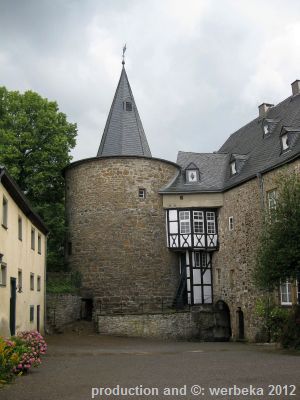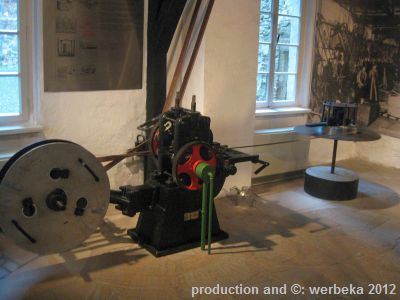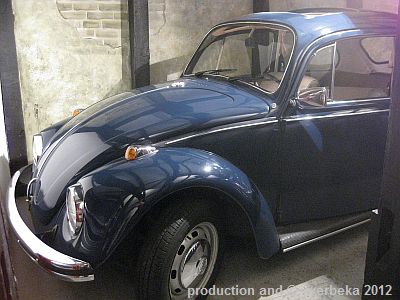
HOHENLIMBURG CASTLE
Hohenlimburg is situated about 20 kilometres south of Dortmund, in the community of Hagen. The history of the castle and with it the history of the town starts in the year 1225. On November, 7th, the archbishop of Cologne, Engelbert II, was killed by Count Friedrich von Isenberg. Exactly one year and a week later, judgement was enforced on Friedrich in Cologne. The count was condemned to death. But his son, Dietrich I von Isenberg-Limburg, came back a couple of years later, in order to regain the lost heritage of his father. On the Schleipenberg he let build a castle, which was finished in 1243. Around the castle a small village grew eventually - the Hohenlimburg of today. But that name was taken by the inhabitants first in 1879, in order to distinguish themselves from Limburg an der Lahn. Before, Hohenlimburg was called Limburg an der Lenne.
The Isenberg-Limburgs reigned the county until 1511, when the family became extinct. The last count, Johann, was married to Elisabeth von Neuenahr. After his death the county and naturally also the castle, was inherited by the House of Neuenahr.
|

The tower of the donjon burned down after a lightening had struck it. At the renovation it wasn't rebuilt to it's former hight. Only the roof was put on it. |
The Neuenahrs expanded the castle and built the first copper hammer in 1571, thus taking the first step towards industrialization. The last count of this dynasty was Adolph von Neuenahr und Limburg. He lost the Colognian War (1582 - 1589) as well as his life, fighting it. Adolph's sister, Magdalena, was married to Arnold von Bentheim, to whose family the heritage was given now. But the castle was occupied by Colognian troops until 1612. The first real regent of the House of Bentheim-Tecklenburg was Conrad Gumprecht, in the beginning of the 17th century. Among other things he let build the Nassauer Schlösschen, a small building in front of the castle, which probably was meant partly as fortification, because now the enemy was compelled to force another port.
Still today the family of Bentheim-Tecklenburg is owner of the castle.
In the Thirty Year's War the castle was captured and occupied again, until it was extensively destroyed by a fire in 1636.
|

The sign over the entry to the Nassauer Schlösschen shows the year 1615. |
In spite of further harassment, not at least through the Sun King, Louis XIV, as well as in the Seven Year's War, the small county reached its heyday in the 18th century. In 1709 the place got the municipal law. More new buildings, as well as expansions, transformed the former fortification into a manor. In the 19th century the family moved to Rheda and the caste was left uninhabited, apart from the first half of the 20th century, when a sideline of the Bentheim-Tecklenburgs lived there.
The county was included into the duchy of Berg by Napoleon and after Napoleon's fall it was to become a part of the Prussian province of Westfalen. Economically there was a downfall of the wire industry, until the cold roll revolutioned the production of steel band. Until today the area around Hagen-Hohenlimburg is leading in that field.
In the old residential quarters of the castle, today there is a museum of cold roll technology, which shows the evolution of the cold roll.
A very friendly, elderly man is happy to explain the background. There is an old photo on one of the walls, showing a factory work room, with rather large dimensions. For everything that was produced there during 8 hours - about a hundred years ago - today we need 4 minutes.
I am not very technically interested, that is why the shown machines didn't touch me in any form. First when going upstairs and seeing the products that were to be manufactured by cold rolling, the visit started to be rewarding.
|
 |
 
In younger days I had written on such an old typewriter myself. The explanation at the side of it tells, that it consists to 60 or 70 percent of steel band and that one used the model with extra large roller for bookkeeping. By the way, I also used to play with model trains ...
Last, but not least, that old, well kept Volkswagen, that was exhibited there, made quite an impression. And the many small things, which made life so much easier, before the plastic industry substituted them, were also made of steel band.
In the new residential quarters, on the other side of the yard, there is another museum, which is supposed to show the forms of living in long gone times. One is given a guided tour with a friendly guide, but the exhibits are not very exciting. Neither have the paintings been made by very big names.
|
 |
On the other hand you get to know, that there is a ghost haunting the castle - you can even see her portrait - and you hear the story about the "black hand", which is exhibited in a glass monter. At least this part is interesting. The hand was cut from its body and conserved. But the owner was already dead at that time; he had been murdered. The hand was needed though, in order to be able to get the murderer convicted. At court it was necessary, that the complainant was physically present. As this is difficult for a victim of a murder, the hand was used as a "stand-in".
|

A view from the outlook-terrace. |
There were many such "silent complainants" kept in one of the towers, but after a lightning had struck it, all those witnesses were burnt. Only this one hand was found in the debris - it had survived the fire in some way.
 |
But it had become all black of the soot and the ashes.
Outside of the buildings there is a beautiful well in the yard; it was built in 1748. One has a beautiful view from the outlook-terrace in front of the castle, as well as from the battlement, where the visitors are left after the guided tour. If the weather is nice, one should be able to see all the way to Dortmund.
|
 |
© Bernhard Kauntz, Wolvertem, 2012
Back to  or to the or to the  of of 
page created: 14.7.2012 by webmaster@werbeka.com
|











